Allegra Marquart: From Paper to Glass
INTRODUCTION
When I signed up for a printmaking MFA at the Maryland Institute College of Art in the late 1970s, an unanticipated perk of the program was enduring friendships with two of the printmaking professors there: Quentin Moseley and Allegra Marquart. While Quentin has kept printmaking as part of his oeuvre of the years, Allegra has all but abandoned printmaking. (Artists changing media is not all that much news. I took a 30-year hiatus from printmaking beginning a few years after getting my MFA in 1979.) I find her new work–colorful etched glass pieces–extremely inviting. I also was fascinated by her process. Fortunately Allegra agreed to let me document her making a new series of glass wall pieces of animals making music together.

As I’ve done with other artists, I emailed her a series of questions. Instead giving answers a question at a time, Allegra chose to submit an essay about her artistic career, including how she makes her glass pieces. I’m not surprised that a person who has chosen to illustrate nursery rhymes and folk tales has chosen to begin….
ONCE UPON A TIME
As an undergraduate, a teacher I respected offered a class in etching. So, kind of typically, I signed up not knowing what I was getting into.
Why was drawing through asphalt, scraping and burnishing metal and rubbing ink into crevices so endlessly involving. It lead me on to learning all kinds of ways of making prints.
After awhile I could choose the best method for realizing the picture in my head: lines needing character and strength called for etching; emphasis on color and shape meant it had to be screenprinting, and to make the most graphic image possible the only answer could be to make large linoleum cuts.
Maybe it was the process, maybe it was the tactile qualities or the magic between the making and the finishing but I was hooked. It’s like falling in love: You can endlessly list what you like about your Choice, but none of that gives you the full answer. Since when was this art stuff ever logical?
The same teacher eventually said, “You should think about graduate school.” Back then no one had told me about that option. But off I went, not knowing what I was getting into! That was the late 60s and that’s where I learned so much more about printmaking.
ABANDONED MEANDERS
I started at MICA in 1976. As much as I loved my teaching job at MICA, by the late 1980s I was saving assiduously in order to take an unpaid two-year leave of absence to find out what I really wanted to do as an artist. The college granted me that gift in about 1990. During that time all forays into movements such as Minimalism and Earth Art came to an end. So did work with hand-made paper and even printmaking. It was back to basics.
Drawing every day with no idea where the marks would lead let loose the narrator in me. The effort became even more concentrated during a month at McDowell Colony.
Later I was ready for the questions posed by Valerie Maynard during a session at the Women’s Studio Workshop. “What would you say if you knew you were going to die tomorrow? Who would you be saying it to? Then make drawings based on that. Or, have a dream tonight and start drawing that, first thing in the morning.”
From out a dream came an onslaught of images called “The Discovery Series” that recalled moments from early adolescence. Here was the beginning of a consistent connected stream of images that have changed in the ways they’ve been realized but have held true to to intent and to a personal aesthetic.
 (left) In a Conversation with Her Bed, 1993, Etching (From the Bedtime Stories series), 10″ x 6” (Courtesy of the artist)
(left) In a Conversation with Her Bed, 1993, Etching (From the Bedtime Stories series), 10″ x 6” (Courtesy of the artist)
(right) Smokers, 1997, Etching (From Street Frieze series), 9″ x 15” (Courtesy of the artist)
From an end to marriage and a move to downtown Baltimore arose a series of images related to the play between men and women called Bedtime Stories and a major group of large two color etchings called Street Friezes. All of it came from personal experience, but much of it was the same as what everyone else experiences. It’s the drawing that makes the difference. Sometimes stick figures seemed the best way to get directly to body language and to emphasize facial expression. The marks had to to be very direct. They had to happen fast and carry energy into the plate and onto the paper. That thick gritty line was, to me, an expression of the force of the experience. I learned not to over think it.
Painting, screen printing and lino cuts were simultaneously important. Some related to the etchings, and others were very different. In the early 2000’s everything shifted and came into sharp focus.
[After several years of reducing her class load, Allegra finally retired from teaching in 2010.]
BEGINNINGS IN GLASS
A friend said, “Have you ever thought of using glass for your images?” I hadn’t. Don’t know why that question resonated so deeply, but within a few weeks I was finding ways to use stencils and sandblasting for this demanding material. Glass was so seductive. It gave me tactility, luminosity, transparency, fragility and vulnerability. It gave me new life.
The first pieces were direct interpretations of various etchings. A self adhesive stencil material was used as the resist for the sandblasting process. This is called cold working the glass because the images are formed without heat. I didn’t attempt any color but learned about the effects of different depths and using light blasting for tonal variation. Glass required me to be even more graphic than I’d been with my prints. That means I simplified and exaggerated more. Every technique new to me has generated conceptual changes too. The craft and the concept were always intertwined.
Sharon Wolf was my sandblaster and really my teacher during that first year. We worked together on flat panels of varying sizes and colors from 2001 through 2012.
FABLES IN GLASS AND PAPER
My use of narrative expanded to fables, old stories and childhood songs when I was asked to contribute to a book being edited by Koren Christofides called Fables of La Fontaine in about 2003. It was new territory that went on forever. Making visual equivalents to well-known tales gave me plenty of room for invention and interpretation but left behind much of what was self-referential.
The Bad Bargain, 2006, Seven panels, relief print, each panel 12″ x 60″ (Photo by Anything Photographic)
Printmaking was ideal for complex stories that I wasn’t ready to commit to glass. One of those turned into multiple 12″ x 60″ relief prints for a piece I call The Bad Bargain. It’s an ancient folk tale sometimes called by other titles such as The Handless Bride or Silver Hands.
I still used etching for very personal statements. A series regarding my mother’s last years acted as a journal, and few have been seen by anybody. While glass, at that time, was carrying what I thought of as my public imagery.
OUT IN THE WORLD
To find out more about what I could do with glass, I spent time at a well known place called Pilchuck in Washington state as well as Penland School of Crafts and Corning Museum of Glass, but I learned and accomplished the most at the Washington Glass School just 45 minutes away from home.
 When the Birds Wanted a King, one of Allegra’s large low-relief glass panels . (Photos by Scott Ponemone)
When the Birds Wanted a King, one of Allegra’s large low-relief glass panels . (Photos by Scott Ponemone)
Using their big kilns I made larger panels in a variety of colors for use with sandblasting. Aesop’s The Race Between the Tortoise and the Hare is a good example of many pieces done between 2004 and 2012. They look a little like cut lino blocks with their low relief and the sharp edges of the shapes. Glass also demanded its due as a medium. After all, if it doesn’t look like glass, why bother? My 2-D way of developing images had already changed to take advantage of low relief and how edges catch light. Now I started making use of the depth of the piece by working on the back too.
A director of WGS, Tim Tate, recommended me to Maurine Littleton of the Littleton Gallery in Georgetown. She looked carefully at these panels and then invited me to exhibit in her booth at the Wheaton Glass Weekend in Millville, NJ in 2007. It was a good weekend.
Littleton has continued to carry my glass work and even shown some of my lino cuts. I’m grateful for that support as I continue with varying approaches to my imagery. (See Allegra’s work at the Little Gallery at: http://littletongallery.com/artists/marquart/)
(left) The Hare and the Tortoise, 2008, 18″x 18″, two colors on sandblasted glass
(right) Why Frogs Don’t Hesitate, 2011, 18″ x1 8″, multiple colors on sandblasted glass (Photos by Anything Photographic)
ANOTHER TURN
The twists and turns and evolutions make it all so fascinating to be making things. Over and over something new has come from a few words from someone who’s watching or from noticing a new product or process that becomes available. It’s opportunism at its best.
But often changes happen because the mind’s eye sees different possibilities. I kept seeing the animals that peopled my glass stories out of the rectangle or square, moving across wide swathes of wall space; going about their people-like business in a light-hearted way. When I discovered a wall mounting system that was pretty much invisible, allowed me compositional flexibility and allowed the figures to appear to float a little off the wall, I was ready to move. It was time for the shapes to take on more dimension and texture.
 Preliminary drawings for Red Glass Jazz Band with two completed figures. (This and the following photos are by Scott Ponemone)
Preliminary drawings for Red Glass Jazz Band with two completed figures. (This and the following photos are by Scott Ponemone)
Step By Step
First comes drawing. Then comes forming the figure in clay. I use the self-hardening kind. Next the clay forms are pressed into dry plaster, which is contained with strips of fiber board on a kiln self. Two sheets of glass are placed on top of this construction. Sometimes the glass carries color in the form of glass crystals called frit. During firing the glass flows down into the pressed shapes. Once cool and rested the excess glass is cut away from the cast figures using a ring saw.

(Above) Two clay figures for Allegra’s Jazz Band lie top down. Notice the little protrusions that Allegra holds when (below left) she presses the figures down into dry plaster. This action (below right) results in a kiln-ready mold for the glass.

(Above) The dry plaster mold (contained in fiber board) rests half in the kiln. Then Allegra places glass on top and slides it into the kiln. (Below) After firing, Allegra inspects the panel.
 The fox is show (left) partially cut out and (right) fully cut out and with a second firing for added color.
The fox is show (left) partially cut out and (right) fully cut out and with a second firing for added color.
Then glass paint is added to the figures if necessary, and they go back in the kiln to fuse the paint and polish the edges. Sometimes accessories are added in the form of copper wire, copper foil or larger shapes cut out of my used copper etching plates. This means traces of previous imagery are still evident giving the shapes history and patina.
The last step is planning the exact posture and positioning of the figures and making a template to guide the installation. Then the mounting stand-offs are adhered to the backs of the shapes.
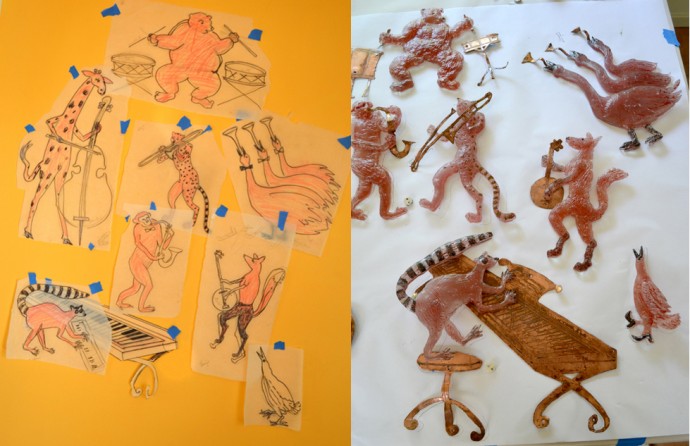 The Red Glass Jazz Band with initial drawing (left) and partial view of arrangement with brass instruments (right)
The Red Glass Jazz Band with initial drawing (left) and partial view of arrangement with brass instruments (right)
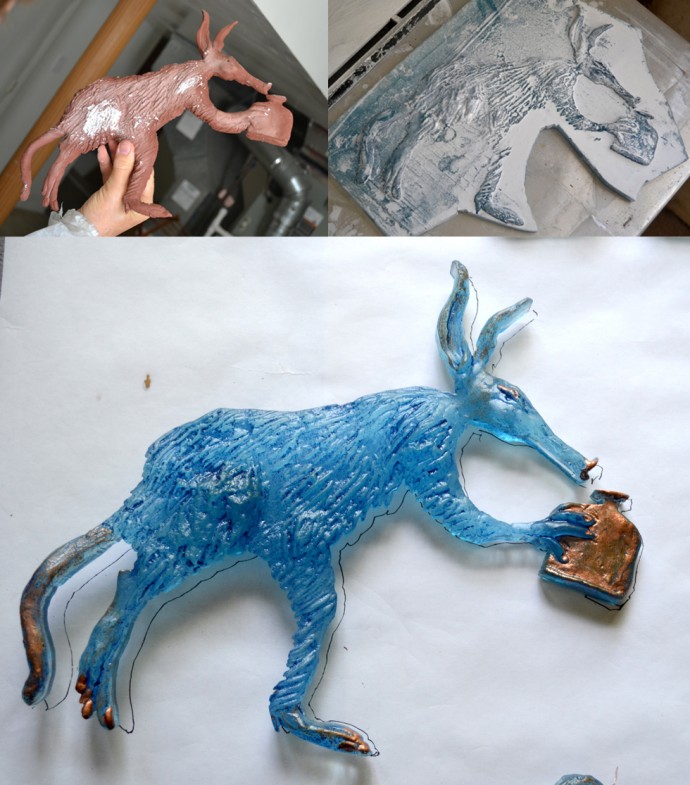 Allegra also did Blue Glass Jug Band. Here’s the aardvark from clay to finished glass. Below are others members of the band, resting on paper that guides the layout.
Allegra also did Blue Glass Jug Band. Here’s the aardvark from clay to finished glass. Below are others members of the band, resting on paper that guides the layout.

 EXHIBITING
EXHIBITING
Whenever there’s a chance to see what I’ve made in a public setting, I see it through the eyes of others and gain a new perspective on it. The feedback ranges from humbling and helpful to encouraging and validating. Exhibiting is part of the creative process for me. It’s another form of motivation. It makes me feel that I’m not working in a vacuum. To some extent it becomes a collaboration with the viewers. This is especially true of people who’ve seen my work over the years. From the gallery directors to friends and the people who help me, I’m always open to their observations and suggestions.
When someone decides to take something I’ve made into their home, I’m so pleased that a connection has been made and someone has traded their good energy for mine.
(Shown mounted on a wall) Blue Glass Jug Band, 2015, Cast and cut glass with painting, copper wire and copper foul, 30″ x 30” (Photo by Anything Photographic)
(Shown mounted on a wall) Red Glass Jazz Band, 2015, Cast and cut glass with painting and acid cut copper shapes, 40″ x 40” (Photo by Anything Photographic)
Trackback URL: https://www.scottponemone.com/allegra-marquart-from-paper-to-glass/trackback/


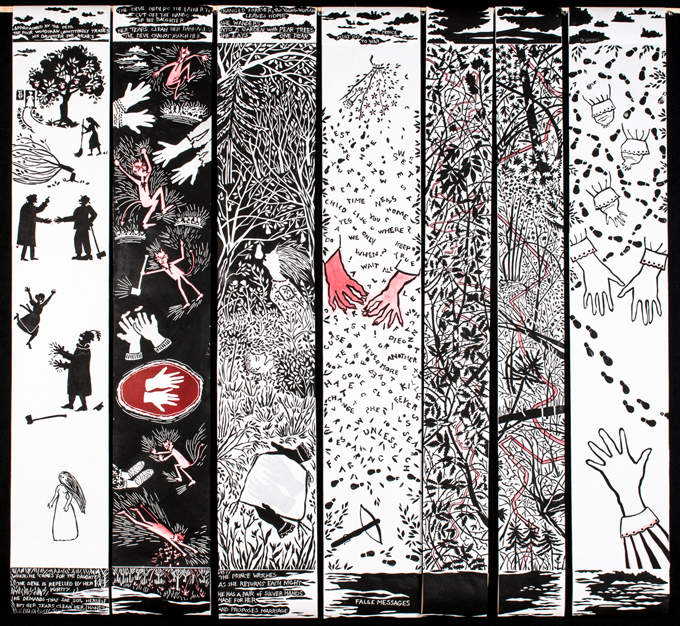
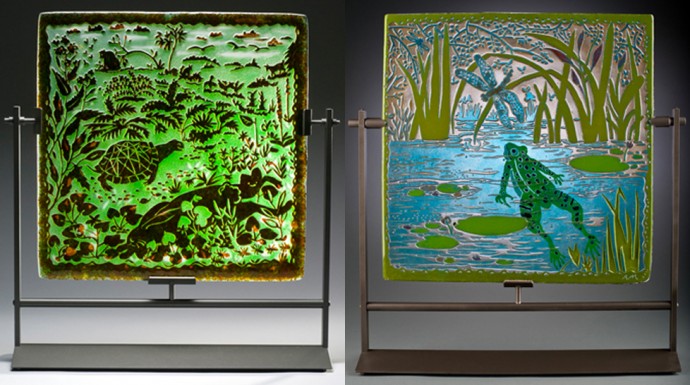


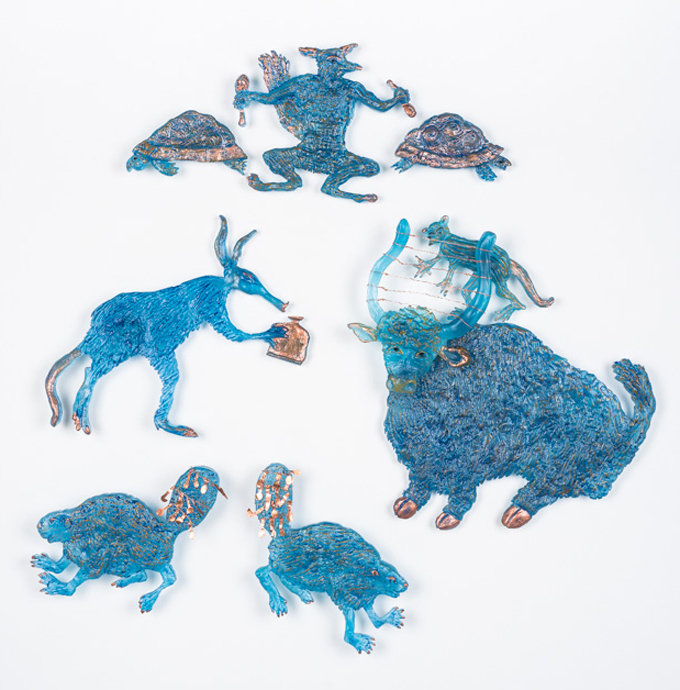











i love these. i haven’t seen anything quite like them. i particularly like the panels with the birds “when the birds wanted a king”
cant wait until i see these in person .
thank you for telling me about your medium and website